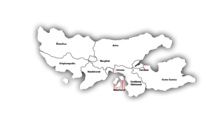Nation/Tarper
| This page is a work in progress by its author(s) and should not be considered final. |
| Bundeskanzleramt of Tarper | ||||||
|---|---|---|---|---|---|---|
|
||||||
| Motto: "Populous meus, ad Astra, ad Astra" | ||||||
| Anthem: Auferstanden aus Ruinen | ||||||
Political Map of Tarper
|
||||||
| Region | Covenant | |||||
| Capital and largest city | Terraum | |||||
| Official languages | English | |||||
| Recognised national languages | German, French, Comijerd | |||||
| Demonym | Tarp | |||||
| Government | Federal parliamentary republic | |||||
| - | President | Frederick Tapia | ||||
| - | Chancellor | Maximilian Großherzog | ||||
| Legislature | Parliament | |||||
| - | Upper house | Bundesrat | ||||
| - | Lower house | Bundestag | ||||
| Establishment : | ||||||
| - | Tarperti-Sangheili État | December 25, 1342 | ||||
| - | 1848 Revolution | January 1, 1848 | ||||
| - | Many Kingdoms Decade | September 9, 1890 | ||||
| - | United Kingdoms of Tarper | June 21, 1901 | ||||
| - | Confederation of Tarperti Communist Republics | November 7, 1912 | ||||
| - | Republic of Tarper | December 26, 1991 | ||||
| - | National Confederation | November 17, 2000 | ||||
| - | Southern Six Union | September 12, 2001 | ||||
| - | Bundeskanzleramt of Tarper | April 16, 2002 | ||||
| Area | ||||||
| - | Total | 643,801 km2 248,573 sq mi |
||||
| Population | ||||||
| - | 2015 estimate | 82,175,700 | ||||
| - | Density | 128/km2 331.5/sq mi |
||||
| GDP (nominal) | 2017 estimate | |||||
| - | Total | 408 trillion (TAK) | ||||
| - | Per capita | 189,969 (TAK) | ||||
| Gini | 16.8 low |
|||||
| HDI | 1 very high |
|||||
| Currency | Tarperti Krup (TAK) |
|||||
| Date format | mm-dd-yyyy | |||||
| Drives on the | right | |||||
| Calling code | +56 | |||||
| ISO 3166 code | TR | |||||
| Internet TLD | .tr | |||||
Tarper, officially the Bundeskanzleramt of Tarper, is a federal parliamentary republic in southern Covenant. It includes 10 constituent states, covers an area of 643,801 square kilometers, and has a largely temperate seasonal climate. Tarper contains about 82 million inhabitants. Tarper's capital and largest city is Terraum, while its largest conurbation is the Great Mountain River Area in the heart of the country. The country's other major cities are Citrone, Himmelstadt, Bergfeld, Hellwald, Long Beach, Saint Constantine, St. Augustine, Morena, and Anchorage.
The Ancient Tarperti tribes have inhabited the eastern parts of modern Tarper since classical antiquity. A region named Tarepere was documented before 100 BCE. Though the migration period for the Ancient Tarperti is known to be much earlier. In the middle of the 12th century, Tarperti territories formed a central part of the Tarperti-Sangheili État. During the 14th and half of the 15th centuries, Tarper and the rest of the État became the centre of the War of Froistonian Agression/Expulsion or 130 years war and the Astran War of Succession. In 1848 the 1848 Revolutions took place and the Imperator of the État was executed and the État was made into a parliamentary confederation. In 1885 the Grand Nationalist Revolutions went on until the Dissolution Treaty in 1890, thus beginning the Many Kingdoms Decade.
In 1900, Tarper became a nation state when most of the Tarperti states unified into the Astran-dominated United Kingdoms of Tarper. After World War I and the First Civil War of 1912-1914, the Kingdom was replaced by the Communist Confederation of Tarperti Communist Republics. The nation fought valiantly in World War II and brought prosperity. In 1960 a member of the Supreme Council took control in a coup and became the dictator of the CTCR. After a period of increasing transparency and economic disparity the CTCR suffered another coup and in 1991 it was dissolved. The establishment of the fascist / ultra-capitalist Republic of Tarper brought the start of a Second Civil War between the National Confederation and Southern Six Union. After a brief outside occupation, the modern Tarperti state was founded.
In the 21st century, Tarper is a great power both economically and politically. Tarper is a developed country with a very high standard of living sustained by a skilled and productive society. It upholds a social security and universal health care system, environmental protection and a tuition-free university education.
Tarper was a founding member of the Confederation of Covenant in 2016. Tarper is a member of the World Assembly (soon), the Tarper-Plamyadia Union and the Tarperdrome. Known for its rich cultural history, Tarper has been continuously the home of influential and successful artists, philosophers, musicians, sportspeople, entrepreneurs, scientists, engineers, and inventors.



